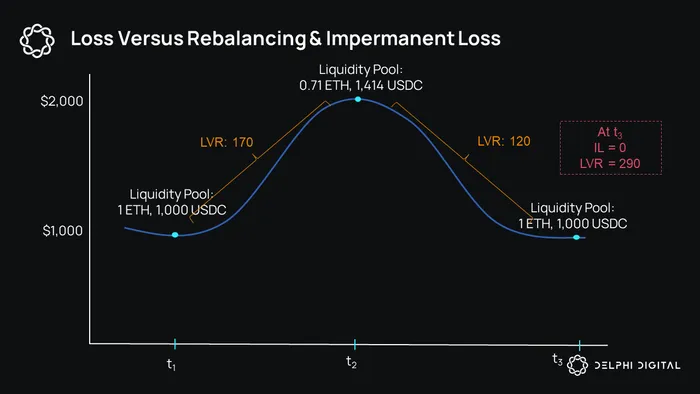Loss Versus Rebalancing (LVR) is a metric designed to quantify the impact of adverse selection on AMM LPs. LVR is calculated as the difference between the value of a liquidity pool and a rebalancing portfolio. LVR can be thought of as the best-case scenario for arbitrageurs.

Though in many ways AMMs are more reliable than order books, they are prone to having stale prices compared to the market. In an exaggerated example, if an AMM quotes ETH at $1,000, and the market price jumps to $2,000, informed traders will purchase cheap ETH from the liquidity pool until the price of ETH reaches $2,000. If the pool originally contained $1,000 USDC and 1 ETH, it would now hold around $1,414 USDC and 0.707 ETH. LPs effectively sold ~0.29 ETH at ~$1,414, well below the true market price of $2,000. The LVR on this trade would be:

If the price returned to $1,000, the AMM holdings would return to 1,000 USDC and 1 ETH, but it would have purchased 0.29 ETH at $1,414, well above market price of $1,000.

If the LP held a rebalancing portfolio and executed the same trades as the liquidity pool on an external exchange like Binance, they would have performed much better.
Once the price of ETH returns to $1,000, impermanent loss would be 0, while LVR would be >0. LVR is a function of volatility and will be >0 unless price remains constant enough such that trading fees offset losses to arbitrageurs. Impermanent loss only looks at a starting and ending point, and compares LP performance to that of an omniscient trader. IL ignores the cost LPs assume by taking the other side of trades with arbitrageurs.
Impermanent Loss has always been a lazy term, as it is more of a “shoulda, coulda, woulda” variable than a concrete metric rooted in reality.
Loss versus rebalancing starts to fall apart when considering its assumptions. Rebalancing on a feeless, infinite liquidity exchange is not a viable alternative for LPs. Like Black-Scholes, LVR also assumes volatility is constant and LPs are delta-hedged.
Furthermore, there are many pairs where Uniswap is Binance, as it is the deepest/most liquid venue and where price discovery takes place. In this scenario, a large portion of the volatility would be noise traders with no edge rather than arbitrageurs.
LVR has some tough to swallow assumptions, but is an earnest attempt at measuring a real variable. Loss versus rebalancing offers a new way to conceptualize the costs associated with liquidity provision. It is likely new DEXs begin to emerge that are LVR resistant, making passive liquidity provision more viable without increasing costs to traders.